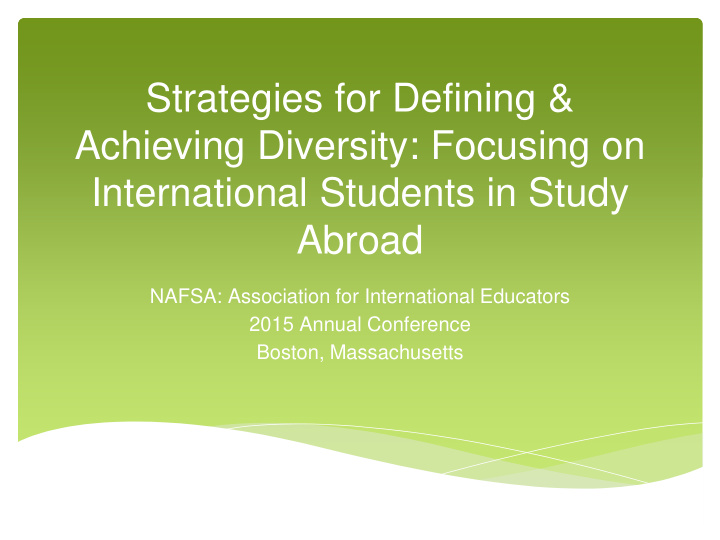



Strategies for Defining & Achieving Diversity: Focusing on International Students in Study Abroad NAFSA: Association for International Educators 2015 Annual Conference Boston, Massachusetts
Link to Prezi ∗ http://prezi.com/7sdoqssp7v7f/?utm_campaign=sh are&utm_medium=copy&rc=ex0share
Goals of Presentation ∗ How to define diversity, specifically looking at international students ∗ How do universities distinguish international students for targeted outreach ∗ What are best practices for working with international students in the pre-departure and re- entry phases
Defining Diversity ∗ The inclusion of different types of people (as people of different races or cultures) in a group or organization (Merriam-Webster) ∗ Diversity/underrepresentation in education abroad refers to student populations that are not highly represented (NAFSA)
Defining International Students ∗ Non-U.S. Citizens ∗ 2013-2014: 886,052 international students studying in US ∗ China, India, South Korea, Saudi Arabia, Canada
Institutional Data ∗ Babson College: 336 (2011-present) ∗ University of Maryland College Park: 216 (2011- Present) ∗ The George Washington University: Unknown (2009-Present)
When and Where are they going? ∗ Short-term ∗ Multi-country programs ∗ Home country students
International Student Quotes from Survey ∗ "My experience of studying in the States is essentially a study abroad experience.“ ∗ "When you're abroad, everything is new and exciting and an adventure."
Retention: Pre-departure ∗ International student considerations - both our considerations and theirs ∗ Co-advising with International Student Advisor ∗ Require a meeting with both International Student Advisor and Study Abroad Advisor ∗ {Approximately 40% of students surveyed had not met with international student services when planning for their study abroad experience}
Collaboration between offices: Connecting the dots ∗ Listing both Study Abroad office and International Student Services office on same website header ∗ Both offices physically located on same floor/in same building/close to one another ∗ Ease of access
Implications: To meet or not to meet ∗ Concerns unique to international students (as opposed to US students) ∗ Outstanding visa issues ∗ US Visa status ∗ Visa for study abroad program ∗ Timeliness/awareness ∗ Who advises international students on the visa process ∗ Language proficiency (English, host country language, other concerns) ∗ All students must work through paperwork, course approvals, finances, living abroad, etc.
Pre-departure: orientation ∗ Making it relevant for international students ∗ We don't want to treat these students as "the other“ ∗ Include exchange students from host country who can relate to the international student experience on the home campus, but also provide relevant host country context ∗ Invite international students who have studied abroad previously, keep them engaged
Re-Entry Programming and Advising: Career Advising ∗ Balance between culturally competent and stereotyping ∗ F-1 Optional Practical Training (OPT) ∗ At job fairs, have companies that will hire international students ∗ List those companies for international students ∗ Connecting with Alumni Services
Re-Entry Programming and Advising: Cultural Readjustment ∗ Adjusting back to U.S. culture, location and course work ∗ Connect students back to cultural organizations on campus or international mentoring groups ∗ Re-entry events or conferences “… it was difficult coming back to the US mentality and stressful environment.” “Getting used to the more individualistic mentality was a challenge. In Ireland, I was used to always hanging out with a large group of friends. In the US, friendships are more 'one- on-one' and not group based.” “The biggest challenge was returning to my home university and adjusting to the workload.”
Re-Entry Programming and Advising: Things to Consider ∗ Living Learning Community in Housing for International Students and Domestic students to intentionally live together ∗ International mentoring group - domestic and international students serve as a mentor for exchange & international students ∗ Networking and re-entry events hosted by Study Abroad, International Service, Career Services, and Alumni Relations ∗ Committee on International Student Success
Small Group Discussion Questions ∗ How does your institution define diversity in study abroad? ∗ What are your diversity goals for study abroad? ∗ How do you identify international students who study abroad? ∗ How does your institutional structure affect international student advising/considerations in regards to study abroad (i.e. size of institution, location, etc)? ∗ What types of resources, both pre-departure and re- entry, does your office or institution offer international students?
References Open Doors Report 2014. (http://www.iie.org/Research- and-Publications/Open-Doors). "Helpful Tips for Non-US Citizens." Office of Study Abroad. Michigan State University, n.d. Web. 15 Apr. 2015. Aguado, L. & Richmond, M. "Study Abroad for International Students: A Guide for Education Abroad Professionals." NAFSA: Association for International Educators, 2014: Web. 23 Mar. 2015. ∗ Grassi, G. & Espiritu, K. "International Students Are an Emerging Market for Study Abroad." International Educator, May & June 2010: 80-82. Print.
Contacts ∗ Kyle Sturges, Education Abroad Advisor, University of Maryland-College Park ∗ E-mail: ksturges@umd.edu ∗ Brett Chin, Education Abroad Advisor, Babson College ∗ E-mail: bchin@babson.edu ∗ Annika Turner, Advisor, The George Washington University ∗ E-mail: akturner@gwu.edu ∗ Hilary Wilson, Exchange Coordinator, The George Washington University ∗ E-mail: wilsonha13@gwu.edu
Recommend
More recommend